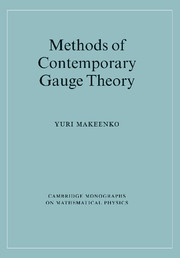Preface
Published online by Cambridge University Press: 02 December 2009
Summary
He reached a much higher plane of creativity when he blacked out everything but a, an and the. That erected more dynamic intralinear tensions.
J. Heller, Catch-22This textbook is based on lecture courses originally given at:
Autonoma University of Madrid, Winter Semester of 1993;
Leipzig University, Winter Semester of 1995;
Moscow Physical and Technical Institute, Spring Semester of 1995;
and then repeated with some modifications at several Universities, Schools of Physics, etc.
My intention in these courses was to introduce graduate students to selected nonperturbative methods of contemporary gauge theory. The term “nonperturbative” means literally “beyond the scope of perturbation theory”. Therefore, it is assumed that the reader is familiar with quantum mechanics as well as with the standard methods of perturbative expansion in quantum field theory and, in particular, with the theory of renormalization.
Another purpose was to make the courses useful for more experienced researchers (including those working in condensed-matter theory), as a survey of ideas, terminology and methods, which have been developed in Gauge Theory since the beginning of the 1970s. For this reason, these notes do not go into great detail, and so some subjects are only touched upon briefly. Correspondingly, the subjects which are usually covered by modern courses in string theory, such as two-dimensional conformal field theories, are not examined. It is assumed that such a course will follow this one.
The main body of the book deals with lattice gauge theories, large-N methods, and reduced models. These three parts are preceded by Part 1, which is devoted to the method of path integrals.
- Type
- Chapter
- Information
- Methods of Contemporary Gauge Theory , pp. xi - xiiPublisher: Cambridge University PressPrint publication year: 2002

